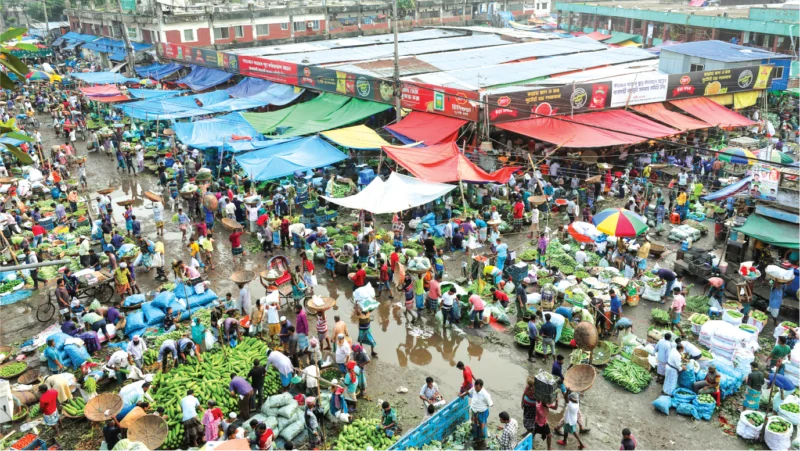
Businesses grappling with rising borrowing costs and surging energy prices are set to face additional pressure in the second half of this year, as the country’s central bank has decided to hold its policy rate steady at 10 percent for the July-December 2025 period.

Bangladesh Bank has sent a clear message: the contractionary stance will remain in force until inflation falls below the 7 percent threshold.
While the central bank frames this as a necessary measure to rein in stubbornly high prices and safeguard macroeconomic stability, the impact on businesses is already being felt.
Key sectors such as ceramics, ready-made garments (RMG), and leather are contending with elevated borrowing costs and energy prices—pressures that threaten profitability and investment momentum.

Prof Dr Mustafizur Rahman, distinguished fellow at the Centre for Policy Dialogue (CPD), warns that these rising costs are undermining business confidence and long-term growth prospects. He urges policymakers to focus on reducing non-borrowing expenses and to introduce targeted support measures.
Without sustained reforms and a more balanced policy mix, he cautions, the trade-off between inflation control and economic vitality may become increasingly difficult to manage.
Businesses Under Strain
For Bangladesh’s industries, the continued high-interest environment presents a significant challenge. Sectors such as ceramics, RMG, and leather—cornerstones of the economy—are squeezed between rising input costs and shrinking access to affordable finance.\

“Maintaining a 10 percent policy rate is a cautious but necessary step in the present inflationary environment,” said Md Mamunur Rashid FCMA, senior vice president of the Bangladesh Ceramic Manufacturers and Exporters Association (BCMEA).
“A disciplined monetary stance will help restore investor confidence, but it must be aligned with supportive fiscal policies,” he added.
He highlighted the severe pressures facing manufacturers: “The ceramics sector relies heavily on a stable gas supply. Frequent gas shortages and substantial price hikes are pushing production costs up by 18–20 percent. This not only reduces profit margins but also makes debt servicing more difficult.”
“Without stable exchange rates and smoother access to credit, businesses will struggle to remain competitive.”
The RMG sector, already confronting new US tariffs, faces similar headwinds. Higher borrowing costs for working capital, coupled with uncertain global demand, threaten to dampen earnings and investment.
Expert Analysis
CPD’s Mustafizur Rahman said businesses such as RMG, ceramics, and leather are facing formidable challenges due to Bangladesh Bank’s contractionary policy, with its high policy rate of 10 percent. The elevated rate drives commercial bank lending rates upward, resulting in increased costs for businesses.

He added that rising gas and electricity prices are further escalating operational costs, making it even more difficult for firms to sustain profitability.
Prof Rahman suggested that Bangladesh Bank may consider reviewing the policy rate once inflation drops to 7 percent. In the meantime, policymakers should provide support to businesses by helping reduce non-borrowing costs.
He noted that reducing inflation depends on multiple factors, including uncertainty reduction, law and order, political stability, fiscal policy, and market management. In Bangladesh, tightening monetary policy alone cannot produce the desired results.
“The current contractionary monetary policy is being pursued at a time when the economy is experiencing investment stagnation,” he said.
Prof Rahman argued that the rate should be revised once a sustained downward trend is observed.
He also pointed out that while contractionary monetary policy aims to curb inflation, high borrowing costs undermine investment and raise the cost of doing business. Such pressures may weaken supply-side responses, which in turn could fuel inflation.
Moreover, high inflation often triggers demands for higher wages, further pushing up prices. The trade-offs are therefore evident.

According to Prof Rahman, reducing the cost of doing business and improving the overall business environment are particularly important when a contractionary monetary policy is in place. Otherwise, the very objective of such a policy could be undermined.
BB Holds Firm
Bangladesh Bank Governor Dr Ahsan H Mansur defended the decision, stating, “Until inflation comes below 7 percent, the policy repo rate will remain unchanged.” He argued that macroeconomic stability is a prerequisite for sustainable growth.

Inflation has eased from a peak of 11.66 percent in July 2024 to 8.48 percent by June 2025. Gross foreign exchange reserves have inched up to $26.7 billion, and the adoption of a fully flexible, market-based exchange rate regime has brought a measure of stability to the currency market.
The central bank cautioned that ongoing cost pressures from past currency depreciation and US tariff measures could hinder a sustained fall in inflation.
Navigating the Road Ahead
Experts emphasised that monetary tightening alone is not enough. Dr M Masrur Reaz, chairman and CEO of Policy Exchange Bangladesh, called the central bank’s stance “the right move in the current context” but warned it must be complemented by fiscal reforms, banking sector consolidation, and supply-side efficiency.

Despite headwinds, growth is projected to rebound to between 5 and 5.5 percent in FY26. The central bank has signalled it may adjust the policy rate if businesses are severely affected by US tariffs, but only in a way that safeguards inflation objectives.
For now, businesses must contend with tight credit, rising input costs, and global uncertainties. The resilience of firms and the pace of structural reforms will determine how well Bangladesh balances inflation control with economic growth.
Written By Sajibur Rahman
Photo: Courtesy






